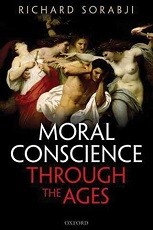THE (Times Higher Education)
Reproduced with permission
Tom Palaima

Richard Sorabji. Moral Conscience Through the Ages: Fifth Century BCE to the Present. Oxford: Oxford University Press, 2014, 240 pp. ISBN 9780199685547
Always let your conscience be your guide,” sings Jiminy Cricket, conscience personified as a kindly bowler-hatted cricket, to Pinocchio in Walt Disney’s 1940 film classic about a wooden puppet being transformed into a real-life boy. It is one of the few significant social pronouncements about the role of conscience in making us human not found in Richard Sorabji’s compact history of the ideas that important thinkers and doers, beginning with Euripides and Plato and ending with Martin Luther, Thomas Hobbes, Henry David Thoreau, Leo Tolstoy, Friedrich Nietzsche, Sigmund Freud and Mahatma Gandhi, have had about how a conscience works, where it comes from, and what good it is, if any – Nietzsche had no use for conscience, believing that modern men “inherit thousands of years of the vivisection of conscience”.
Sorabji’s close reading of subtle arguments spanning 25 centuries, as he transliterates key Greek and Latin terms and does his best to define their particular meanings in different periods, enables us to see how later figures took up or rejected earlier ideas. Gandhi, for example, came to believe unshakeably in his “still small voice within” – no Jiminy Cricket for him – as “the true voice of God”, as it steeled his commitment to non-violent social actions. Gandhi’s voice of God, we learn, sounded a lot like Tolstoy in his 1894 treatise The Kingdom of God is Within You and Socrates in Plato’s Apology, set in 399BC.
The Greek word for conscience first appears in passages in the work of late 5th-century playwrights where characters wrestle with what we would call moral choices, or defects in Sorabji’s view. The Greek compound verbal formation expresses the notion of a shared knowing (sun: “with” and oida: “know”, literally “I saw and I still see”), Latin con-sciens. The precise meaning of conscience is further complicated by the abstract nouns used for it that are derived from other verbal roots, eg, sunesis and the Latinised sunderesis. The notion of with-ness is the common element.
The key question is: shared with whom? In Sorabji’s view – surprisingly given the role that conscience plays in our interactions with others – we share our thoughts about moral behaviour and moral choices with ourselves. Conscience splits us into two people. From this come expressions like “I could not live with myself” and feelings of having a voice within or a cricket or guardian angel advising from without, as in Freud’s superego or Socrates’ daimōn.
Sorabji also argues that the original concept of conscience, ie, “sharing knowledge with oneself of a defect”, was a largely secular idea. Stoics and Christians turned conscience into a religious concept associated with the law or will of gods or God. Michel de Montaigne, Hobbes and John Locke began a resecularisation process that continued through Thoreau’s civil disobedience and then on to conscientious objection to armed service during the First World War.
But what does a largely secular idea in ancient Greek look like in context? Sorabji gives few original source passages at any length. Conscience appears as a daimōn in Plato’s Apology and arguably also in Euripides’ Orestes, where grief is called a terrible goddess in a kind of chiasmus. So how the Greeks viewed daimones becomes relevant to whether conscience ab origine is secular or religious or something in between. And Hesiod’s thoughts two centuries earlier in Works and Days about daimones as immortal and beneficent guardians of justice should be relevant, too.
Tom Palaima is professor of Classics, University of Texas at Austin.